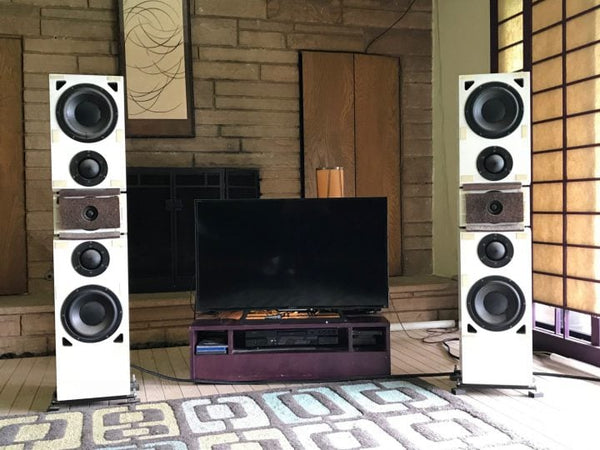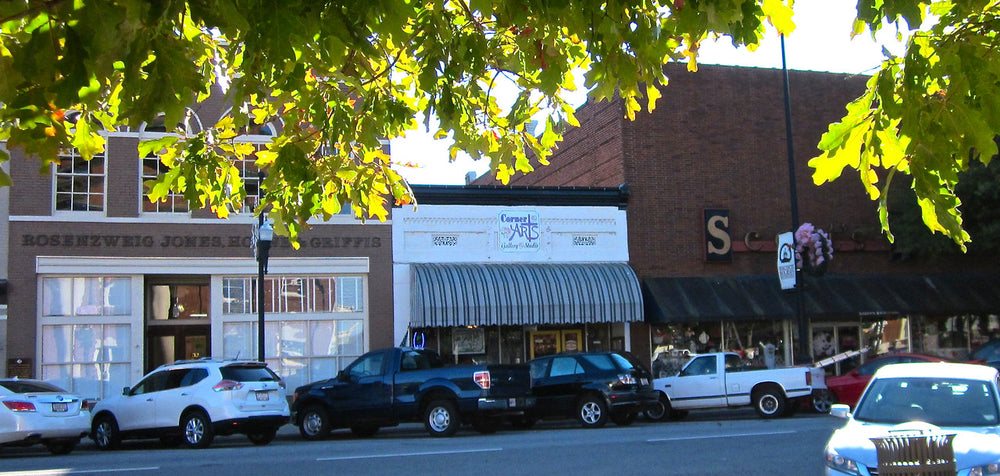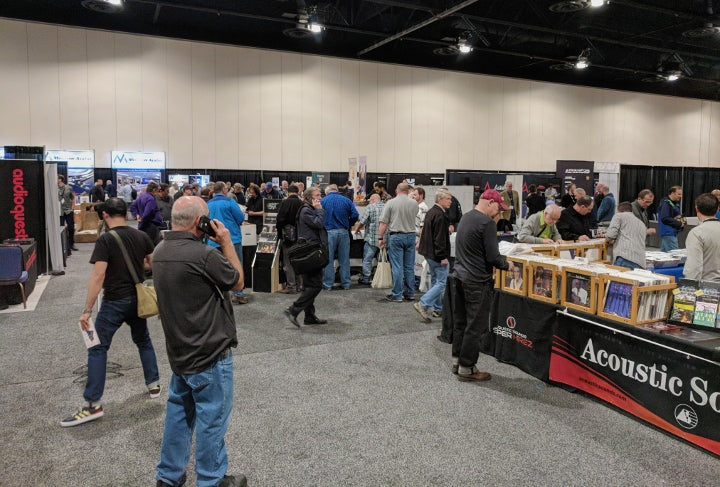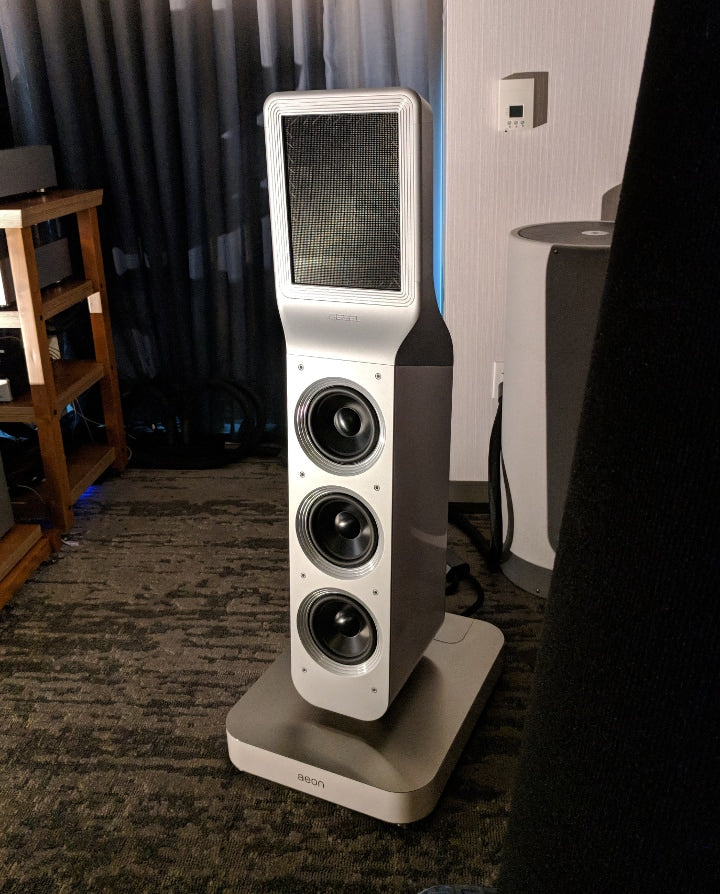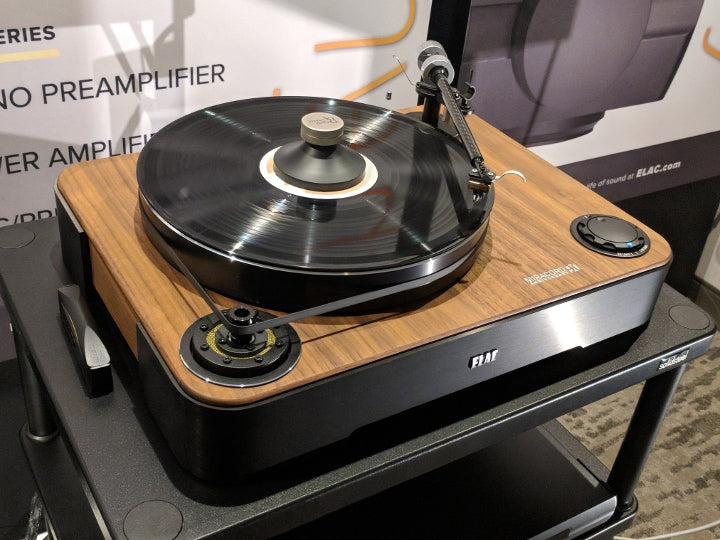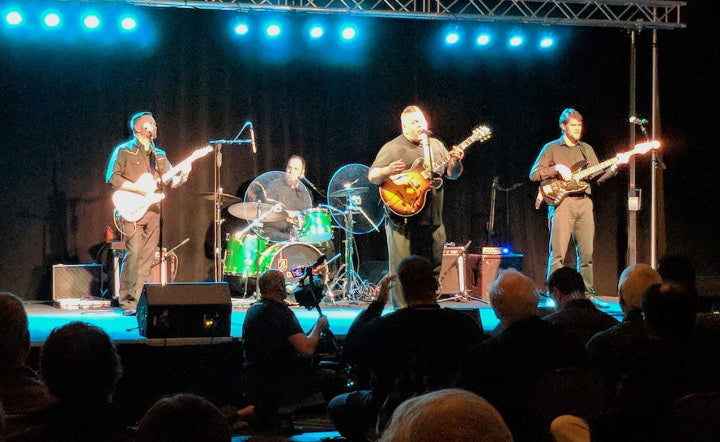[Copper‘s Dan Schwartz had a lengthy conversation with concert promoter/raconteur Rikki Farr at his office at Riva Audio. Part 1 appeared in Copper #56; Part 2, in Copper #57. This is the third and final installment of Dan and Rikki’s chat. I hope you enjoy it! —Ed.]
D.S.: So – the Maoists and the draft dodgers at the Isle of Wight. Did you..?
R.F.: Well, they’d just destroyed a festival in France, in Montpellier. They came in these luxury buses with their stencil machines…they had the money to come across on the ferry, and on the buses, and all of the cost – and their message was that music should be free. And they would give out these leaflets: “don’t pay – you don’t have to pay, you can go on the down…” Now a lot of kids just said, “Screw you!” and they paid. If everyone had paid, that would have been a huge success, and we were then going to go and build a permanent site on what is now the Isle of Wight, but they just tore it down, they broke it….
D.S.: Why do you call them Maoists?
R.F.: Because the French guys referred to themselves as Maoists. They were the ones with the red headbands. But there was another faction run by a little guy who looks like Charles Manson The one who chipped Joni Mitchell’s tooth. He was…I received a bullet. Kris Kristofferson and I were backstage, talking, and he was ready to go on, and I got a Coca Cola can with a note and a bullet. It said, “The next one’s yours.” That’s why in the movie, you see Kris going on stage and he says to me, “I think they’re going to shoot us.” And you couldn’t hear me saying, “Where would we go? There’s nowhere to go!” (laughs)
And that came through the microphone. The crowd heard that. He’d just finished “Bobby McGee” and he wasn’t really in tune, and his band wasn’t really together. And Kris – it wasn’t a good performance. And the audience went aggro; the Maoists lit a fire, were setting fire to things, burning down…
D.S.: So they identified as Maoists?
R.F.: The Frenchies? Yeah. And there was thing of, “music should be free.” And I got hold of a couple of them and I said, “How should it be free? This guitar has to be paid for. This electricity. The toilet you’re using. Who cleans it? The water you’re drinking. Where you park your bus. You can pay 10 pounds to come over here and 10 pounds go back. You can’t pay 7 shillings and sixpence for 5 days of the best music ever assembled?” “Ah, but music must be free!”
D.S.: I hope they’re happy.
R.F.: They’re not, they’re not.
D.S.: I mean, music is free, now – of course not – there’s the cost of producing…
R.F.: Yeah, but – it isn’t, really. It’s just repugnant . So when you listen to what I (said): “We built – we worked a year for you bastards.” That was at the Maoists – and they knew it, because they’d now got into the front area, the press area, and they were occupying it. The press had moved out. It was like, “We don’t want to deal with this.”
And they were spitting, and they were at the stage. That one guy, who was an American draft dodger – looked like a real thug – I invited him onto the stage. I said, “Hey, the mic’s yours.” And he got up and made such a fool of himself. You can hear the crowd just booing him. “I was at Woodstock, man! That was free, and it was love and peace! This is a concentration camp, man!”
I’d already explained that the government made us put the wall there as it was a matter of sanitation safety. That killed us; the cost of that. We actually had no intention – there was one road in, we literally were going to put a pay desk at the far end, and people would come in and carry on down the road. We were going to do it that simply. The year before, we had, literally, scaffolding pipes with black screens. Some people cut their way through and came in free. But not many. From a sanitation point of view, we had to maintain the site. They made us put a solid wall there, and it was horrible. I gave these guy the paint – big mistake. I said, “Look, paint it – put some love and peace signs on it.” And then the Maoists put “Fascist Pigs” and “Kill the Pigs – Music should be free!”
D.S.: Seven shillings sixpence was 90 cents. For five days?
R.F.: Yup. What we should have done was make it 5 pounds. And everybody said it was ridiculous. Camping was free; toilets and water, food was subsidized. We built 4 churches for the different religions, children were born…I mean, we had a city the size of Brighton.
D.S.: A pound a day wouldn’t have been unreasonable.
R.F.: No, no. Absolutely not for that bill.
D.S.: So why did you pick 90 cents?
R.F.: Well, we felt the amount of people we knew the deal would come. The one thing was – I was labeled a Communist by the government – a perverted Communist – they had a thing about me inserting a straw into my scrotum for sexual pleasure – that I’d never done in my life and never heard of since. But I think it was one of those members of Parliament – God knows what they did up to. You see the gay clubs they go to, where they get whipped over having their fish and chips by a girl in a leather skirt…
D.S.: Well, at least it’s a girl!
R.F.: (laughs) Well, sometimes you wonder. The Boot and Flogger was a famous place where you’d gather the MPs and they’d all be hauled over and have their bottoms smacked before lunch! (laughs) The British are a strange bunch!
D.S.: There are certainly rumors like that!
R.F.: No, I’ve been there! Really. Remember, I had all the clubs in London. The Boot and Flogger. There’s so much scandals going on now…
D.S.: A scandal like that would be relatively harmless.
R.F.: Well, I knew Christine Keeler really well. And Ward [?}] also – I mean, his suicide and everything, that was just so – crazy. It was the sixties, for Chrissake. Everyone was discovering their sexual freedom. Girls – you know, it was just an amazing era. And it was born out of this music that was coming and it was tribal. There was the Carnaby Street tribe. The Soho tribe. The Notting Hill tribe.
D.S.: So do you think people picked their tribes?
R.F.: I think they gravitated to where they thought they could be the most successful; where they thought their contribution would be meaningful.
D.S.: That’s really interesting – tribal.
R.F.: That term came to me with Newcastle. Manchester came later, with Duran Duran and so on and so forth. But Nottingham. And then later on, Sheffield. A lot of bands out of Sheffield. And a lot of hair bands, like Def Leppard and so forth.
D.S.: But tribal suggest that people identified with a tribe rather than coming from a place.
R.F.: Well, I’ll give you a for instance. If you were at the Blue Boar, which was a cafe on the M1, on a late Saturday night, early Sunday morning, all the Four Temps [?] traders, which was the van de rigeur of the traveling vans and equipment – that’s what they scuttled all over England in – setting up and pulling down. Bags coming the North back to London, bags from the South coming back up North, we’d all meet there for a cup of tea, and eggs and beans on toast…I tell you, if you’d thrown a hand grenade into the Blue Boar, you’d wipe out what is now the legend of British music. And y’know, there were those going up to Liverpool, there were those going to Birmingham, those going to Sheffield, those going to Newcastle…and this was not dissimilar as I would say, from the way the British [follow?] their soccer teams. They’re tribes. They wander around, they go to huge lengths to travel…if they’re playing in Moscow, you’ll see 8,000 guys from Liverpool.
D.S.: Did you ever have any interaction with the Grateful Dead?
R.F.: I did, because of my relationship with The Tubes.
D.S.: That’s the best example that I can think about of a tribe in America.
R.F.: Yeah. Very much so. Well that – I would even go beyond “tribe” and say “cult.”
D.S.: Well – and then you just make it bigger, and it’s a religion!
R.F.: Yeah – absolutely. But when you think of them, you identify with where they come from. The Bay Area. So that’s what I’m talking about. This is a Liverpool band, this is a Manchester band…and I think England, by its very nature, if you look at history, England was broken up into territories: the Sussex men, the Kentish men, the Yorkshire, the Welsh, the Devonshire…you can’t believe a country that has so many different accents. I mean, you can travel 400 miles and you go from top to bottom, and if an American goes the whole North to South, they can’t understand half the people they talk to – but it’s all English!
D.S.: I’m very glad for subtitles…when I watch Scottish films, you know?
R.F.: (laughs) So it’s – when everyone gravitated to London, and London became the hub, and if you could come to London and play, and sell out, and you could really have a following, that was the real…nobody really aspired to go to Liverpool and sell out a crowd of people there. Gary and the T Bones went to Liverpool – packed – but you made it if you went to London and you could go to the Marquee – even though we were licensed for 540 people, we’d get 1500 there. I mean, it was the black hole of Calcutta.
D.S.: I remember. Even in ‘86 still.
R.F.: Oh yeah. I remember it well. Well, I sort of remember it – when I talk to someone like yourself, it becomes very pictorial in my thinking.
D.S.: What are you proudest of? Of everything you’ve done?
R.F.: My children.
D.S.: And what was the biggest disappointment for you?
R.F.: My biggest disappointment was the editing on The Isle of Wight. It could have been…I mean, I understand he had to show the anarchy, but not make the whole film about the anarchy. And I think that if you had taken the beautiful colors and things that they filmed, like Sly and the Family Stone waking everybody up at dawn to the sunrise –
D.S.: What did they play?
R.F.: I went to Sly, and he was so high, and there were mounds, like little mole mounds for miles around, of people sleeping. Occasionally a body would be wandering around to go to the bathroom or on a trip = but mounds and mounds of people. And he went onstage, Jeff Dexter announced them, and I was that far from crispy. And he grabbed a mic and starts going, “Boom chaka laka laka, Boom chaka laka!” (hums “Dance to the Music”) and all of a sudden these mounds started to wake up. 20 minutes later, the sun came up and it was just magical. “Murray, why didn’t you put THAT in the film?” “I’ll put it in the new film!” Well, Murray died. Died few months ago, 4-5 months ago. And he just called me two months before: “Let’s do it.” And I said, “Do it – but let’s edit it right.”
My biggest disappointment is what that film could have been – because the recordings are so good. I mean, some of those recordings…
D.S.: How was it recorded?
R.F.: You won’t believe this: it was recorded from under the stage with 4 Nagras. That’s why we had dual mics. Roger Daltrey wanted a single mic, and I said, “No – have it. We’re recording.” Well, The Who got 3 albums out of it!
D.S.: So – the Nagras were running one after the other, or were you running 2 and 2?
R.F.: We were running them in pairs – in stereo; they were mixed down later. And some of those records are awesome! And considering the crudity and the way we were recording them…now, my wonderful dear friend, Charlie Watkins from WEM [Watkins Electric Music, British leaders in development of high-powered PA systems—Ed.], my brothers, the Floyd, and ELP with their new PA, everybody donated their PAs. And we just loaded them up and put them out…and then the Maoists were trying to tear the towers down. There was 10 tons and huge power. They toppled those over, there’d have been mass deaths. I was living on such tenterhooks from those idiots. And they had no clue what they were doing.
D.S.: They were just trying to disrupt?
R.F.: Well, you also had that other guy, a complete idiot: Mick Farren, who had a band – I can’t remember the name; they’re so unmemorable – I tried to give them dates and nobody would turn up. Mick Farren and the Deviants. Something and the Deviants. And I put them on The Isle of Wight and the crowd just didn’t hear. He was trying to be the MC and he wasn’t. So I became the enemy and he was going to destroy me, and he did a cartoon of me as a pig…and I wasn’t a pig when I was getting him concerts and paying him, and putting him on the South Sea with the early Fleetwood Mac.
D.S.: I loved that early Fleetwood Mac.
R.F.: They were wonderful! Now Peter Green…You’re talking about another favorite! I’m still good friends with Mick. In fact, he has a restaurant in Maui, and I visit him. Actually, I got a ping from him asking when was I coming over again? I still have people whom I stay connected with from time to time. I don’t live in that vacuum where I have to seek out my past. I’m so determined to rectify some of the treason that’s been done to the music by the new ways of playing music. And this is why my company, Riva, we’re getting so incredibly well talked about by the press and the industry. We’re starting to get some real recognition for bring back the real honesty of instruments and how they’re played, how they’re recorded, and the voices, and the nuance and the separation. We’re really taking off, and I’m surrounding myself with some really brilliant young people, who, frankly, are making me look really good. Not 100% deserved, but at least I was a compass point for them.
I’m 75, I feel 50, and I’m as happy as a man who’s right minded. Couldn’t be happier.
D.S.: Is there a field you haven’t worked in that you would like to have worked in?
R.F.: When I did the acting, I loved the acting. I found it a little boring – the filming was boring; when I did the reformation film for the Royal Academy…but apparently, I won an award for that film for best unknown actor, or something. Never followed it up, frankly. Took off to the trawlers to make some real money. But doing the repertory theater and The Little Theater in Lewis – and doing Dark Side of the Moon…
D.S.: So that was sort of a passion that didn’t get fulfilled?
R.F.: I felt I was able to play a part, transform myself, and understand the lines – and completely not be Rikki. Of being this part. And I don’t know if it was emotional or egotistical, or a combination – but having like – when I played the Golden Boy [1937 Clifford Odets play in which the aspiring-violinist protagonist destroys his hand boxing—Ed.] – and my father wanted me to be a violinist, but I’d been a boxer and I’d broken my hand – and I remember just the light on the stage, and how my trainer would help take off the glove…and my hand, it wasn’t broken; it was like this. But I was able to look at it and the audience felt it was broken – And I’d literally hear people gasping – and I realized I’d probably never play the violin again, for my father. And it was – it made me feel that I was able to – it gave me a sense of power; in being somebody who I wasn’t. And giving people watching, in a live sense, it gave me – it was thrilling. And it took me quite a while, after, like Christine McNamara went on to have a great career. Peter Cleall, a great British television actor…we were all in this. And somebody said, “C’mon let’s do more; we’ve got a lot of offers to do things.” My mother really wanted me to do it, but I….going into Kaiser Keller, cheap perfume, drunken sailors, prostitutes, and Bo Diddley was kind of where my heart was! (laughs)
D.S.: It seduced a lot of people.
R.F.: Yes! And…I think I could have been quite good, with the acting. Only because I’d inherited my father’s fearlessness. You know, someone said, “You have half a million people at The Isle of Wight? That’s double Dunkirk!” And I go, “Okay.” And it was just blind ignorance.
D.S.: It hadn’t been done, so you didn’t know!
R.F.: You know, if people are constantly telling me you won’t do it, you can’t do it, whatever – it stirs something up in me – “Well why can’t you do it?” I mean, he – if he’d stayed in the coal mines, he’d be dead by 23. But he got out, went to all the local pubs, put the chairs in a circle, and said, “I’ll take on anybody.” Grown men, minors, shepherds – you name it. And that’s why they called him “Legs” Farr – ‘cause he’d dance and dance – because if they couldn’t knock him out in 3 minutes, they’d put the money in a hat – his brother, Doug would go collect the money – and he’d jab and duck and jab – and then one day, Joe Gess’ boxing came to town, and he signed up. He was too young to fight, but one day, a guy was cutting into the tent to get in for free. My father was there to sort of keep an eye on things. He bent him with a left hand and knocked him out. Joe Gess said, “You’re ready for the ring.” So that was “Kid” Farr, and he took on all comers.
One of the ironies was that his pit boss, who’d beaten him remoresely with a leather belt, got in the ring to fight him. And he beat him and beat him – he actually got on top of him and they had to pull him off. And that wasn’t a fight – that was revenge. But he had to hitchhike to London for his first fight. He was sleeping in a haystack and his feet were tickling him. He woke up to see a bull licking his feet! And he worked on the barges on the Thames to make enough money to go to training camp and then have his fights.
When he got into the ring with Hitler’s great Walter Neusel, who was on the posters for the True Aryan, and Goering and Goebbels were there, Ribbentrop was the and my father hated – this was before anyone realized what a swastika was, but they had them. My father and the Welsh were all seen as [?German term]. My father recorded the fastest knockout—[?inaudible] screamed. This was the days of the 3 oz gloves. He looked up, and there was Goering and Ribbentrop, leaving the royal box. And that’s why Hitler put my father on is death list. He was going to have his Chancellery overlooking the bandstand at Green Park. That’s where he was going to have all the “hangers”. He was looking at Churchill and said, “I will hang him like a chicken from his neck.” And Churchill said, “I tell you, Mr. Hitler – some chicken, some neck.” (laughs)
[That concludes Dan Schwartz’s conversation with Rikki Farr. Thanks so much to Rikki, and special thanks to Christine McKibban at Riva Audio and Jim Noyd of Noyd Communications for arranging Dan’s chat with Rikki.]





